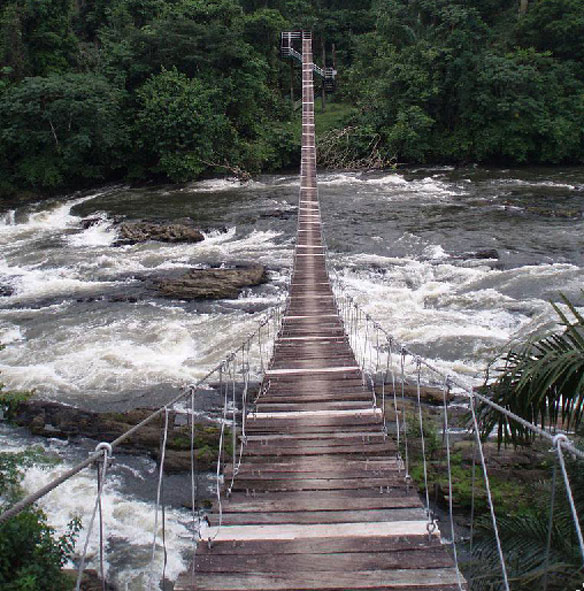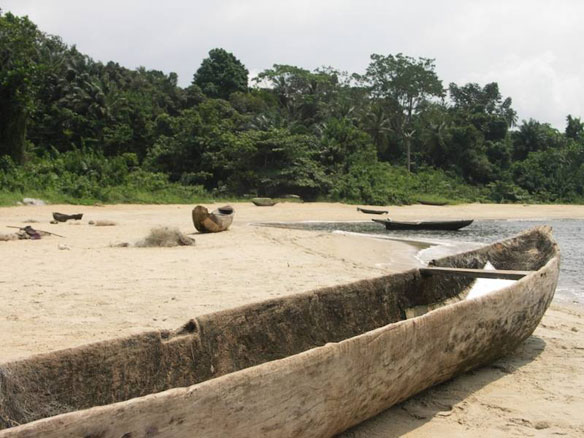
Cameroon. Photo source: ©© zzilch
Located in the southwestern corner of Cameroon, bordering on Equatorial Guinea to the south and the Atlantic Ocean to the west, the Campo-Ma’an National Park and its buffer zone cover an area of approximately 700,000ha. Here, one finds 80 species of mammals, such forest elephants, leopards and gorillas, as well as 302 bird species, 122 reptile species and 250 fish species. Threats to this rich biodiversity include coastal development, unsustainable and illegal logging, and poaching. Captions: © WWF
By WWF,
In 2011, WWF produced a map of the protected areas of Cameroon at the request of the government. Simultaneously, observations had been made by conservation groups that mining permits were being granted inside of Cameroon’s protected areas, though the origin and credibility of the data was unclear.
Also in 2011, several mining companies presented their credentials to the conservators of the Campo Ma’an and Nki National Parks to inform them that they would begin mining exploration activities inside these protected areas. This propelled WWF, CED, and RELUFA to make an official request to the Ministry of Mines in Cameroon for all valid mining permits.
Using official data only on mining permits granted or renewed during the period spanning 2009-2011, the authors and GIS experts produced a mining map of Cameroon which is the basis of this paper. A limited number of oil permits were also made available to the researchers. The authors are aware of the existence of further mining and oil permits that do not appear on the map as the official data has not been made available.
The report reveals that there currently exists 30 mining exploration permits overlapping 12 protected areas, and dozens more are in the immediate vicinity of protected areas, with a high potential for conflicting with the government’s conservation objectives. In addition, petroleum permits have been granted in an additional four protected areas. Under Cameroon law these overlaps are illegal.
Some of Cameroon’s most important protected areas, including Korup National Park, Dja World Heritage Site, Nki National Park and Bouba N’Djijda National Park, which harbor much of Cameroon’s natural heritage, are threatened by these permits. The Ministry of Forestry and Wildlife, mandated to manage these areas, did not give permission for these permits, as required by Cameroon’s mining laws.
Whilst it is clear that Cameroon and indeed the Congo Basin is rich in minerals, and these minerals need to be extracted in order to deliver economic growth, such overlapping conflicts do not project a smooth path towards economic development.
The report proposes that, worse than this, such land-use conflicts could lead to large compensation payouts, potentially tarnish the reputation of Cameroon in terms of conservation leadership in the Congo basin and damage the country’s Doing Business ranking.
The report recommends that granting of future permits be suspended until a clear process is implemented to avoid future land-use conflicts. Finally, the report proposes that portions of mining permits overlapping already existing land rights be “cut” (re-delineated)…

Korup National Park is in the Southwest Province of Cameroon and extends over 1,260 km2 of mostly undisturbed primary forest. It is reputedly one of Africa’s oldest and richest rainforests in terms of floral and faunal diversity. It is 50 km inland from the Bight of Biafra, 20 km from the edge of the mangrove swamps of the Rio Del Rey estuary and partially borders Nigeria. Captions and Photo source: Wikimedia
Liberia’s Hasty Forest Sell-Off Risks More Conflict, Guardian UK
More than half of Liberia’s forests — dense and packed with rare and endangered species, sprawling for hundreds of miles over the small coastal country — have been granted to logging firms, bypassing environmental laws and with few benefits to the people.
UN Adopts Historic Land Grab Guidelines, BBC News
Over the past few years, companies and foreign governments have been leasing large areas of land for farming and exploitation, in some of Africa’s poorest countries. All evidence points to a phenomenon of unprecedented scale, raising serious questions about the terms of the contracts that governments are signing up to..









